AMX WAP250G WIRELESS ACCESS POINT User Manual sap2315a mg
AMX LLC WIRELESS ACCESS POINT sap2315a mg
AMX >
users manual
WA6102-ZZ
SAP2315A
802.11b/g Access Point
Management Guide

Management Guide
Guide
802.11b/g Access Point
IEEE 802.11b/g Wireless Access Point

SAP2315A
E062006-EK-R01
FEGFT2315000E

v
Table of Contents
Chapter 1: Initial Configuration 1-1
Logging into the Web Interface 1-1
Using the Setup Wizard 1-2
Chapter 2: System Configuration 2-1
Information 2-3
System 2-3
Client 2-4
Network 2-5
Event Log 2-6
System Settings 2-7
Administration 2-7
Operation Mode 2-8
Reboot System 2-8
Wireless VAP Settings 2-10
Basic 2-10
Channel Setting 2-11
WEP Security 2-11
WPA-PSK Security 2-12
Network Settings 2-14
DHCP Client 2-14
DHCP Server/NAT 2-15
PPPoE 2-17
Time and Log 2-18
Updating Firmware 2-20
Upgrade via the Web Page 2-20
Upgrade via a Remote Server 2-20
Appendix A: Troubleshooting A-1
Glossary
Index

vi
Contents

1-1
Chapter 1: Initial Configuration
The Access Point offers a user-friendly web-based management interface for the
configuration of all the unit’s features. Any PC directly attached to the unit can
access the management interface using a web browser, such as Internet Explorer
(version 5.0 or above).
The initial configuration steps can be made through the web browser interface using
the Setup Wizard. It is recommended to make the initial changes by connecting a
PC directly to the access point before installing it in its intended location. The access
point has a default IP address of 192.168.1.20 and a subnet mask of 255.255.255.0.
If your PC has an IP address on the same subnet (that is, the PC and access point
addresses both start 192.168.1.x), you can connect immediately to the web
interface. Otherwise, you must first change your PC’s IP address to be on the same
subnet as the access point.
Logging into the Web Interface
In the web browser’s address bar, type the default IP address: http://192.168.1.20.
The web browser displays the access point’s login page.
The User ID is fixed as “admin.” There is no default password, so just leave the
Password box blank and click LOGIN.
Note: It is strongly recommended that you configure a password. If a password is not
configured, the management interface is not protected and anyone that can
connect to the access point may be able to compromise your network security.
For information on configuring a password, see “Administration” on page 2-7.
Figure 1-1. Login Page

Initial Configuration
1-2
1
The home page displays the Main Menu. There are two options available, you can
configure the basic features of the access point using the Setup Wizard’s simple
steps, or you can configure all features in detail using the Advanced Setup menu.
Figure 1-2. Home Page
Using the Setup Wizard
There are only a few basic steps you need to set up the access point and provide a
connection for your Wi-Fi phone and network access for other wireless stations.
The Setup Wizard takes you through configuration procedures for the general
network settings, such as IP configuration, wireless network name (Service Set
Identifier), and wireless security. Follow these steps:
1. Launch the Setup Wizard – Click “Start with Setup Wizard” on the home page.
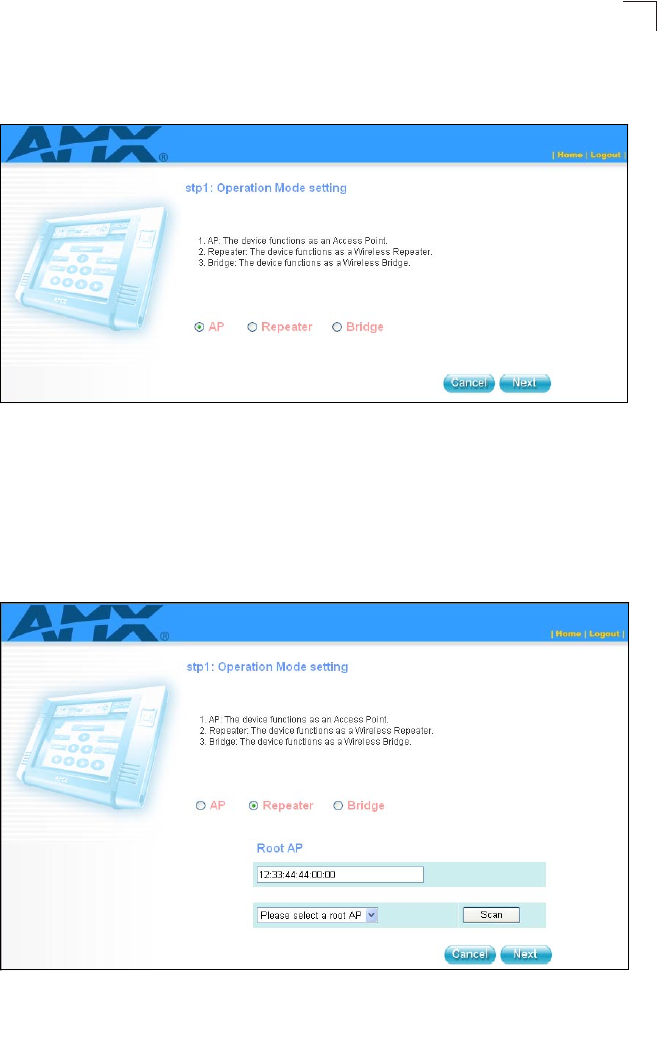
Using the Setup Wizard
1-3
1
2. Operation Mode Setting – Select an operation mode according to how your
divice will function.
Figure 1-3. Setup Wizard - Network Setting (AP)
There are three operation modes:
•AP — Set the device as an Access Point.
•Repeater — Set the device as a Wireless Repeater to relay messages
between subnetworks that use different protocols or cable types. The Root
AP MAC Address can be assigned manually or selected after click “Scan”.
Figure 1-4. Setup Wizard - Network Setting (Repeater)
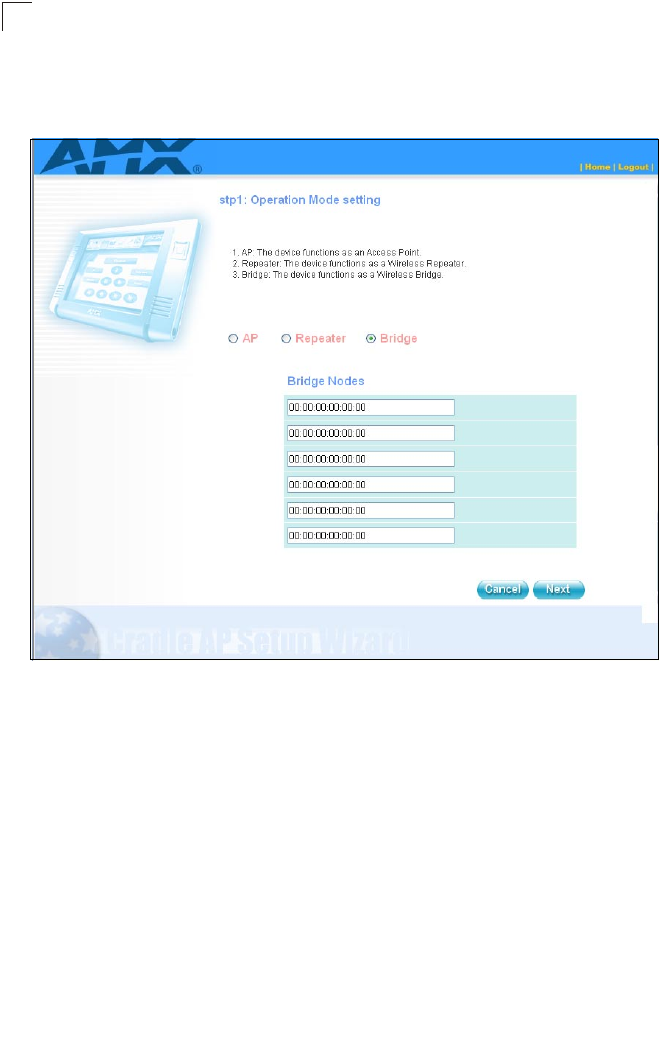
Initial Configuration
1-4
1
•Bridge — Set the device as a Wireless Bridge to connect two local-area
networks (LANs), or two segments of the same LAN that use the same
protocol. The Bridge Nodes need to be assigned manually by the user.
Figure 1-5. Wizard - Network Setting (Repeater)
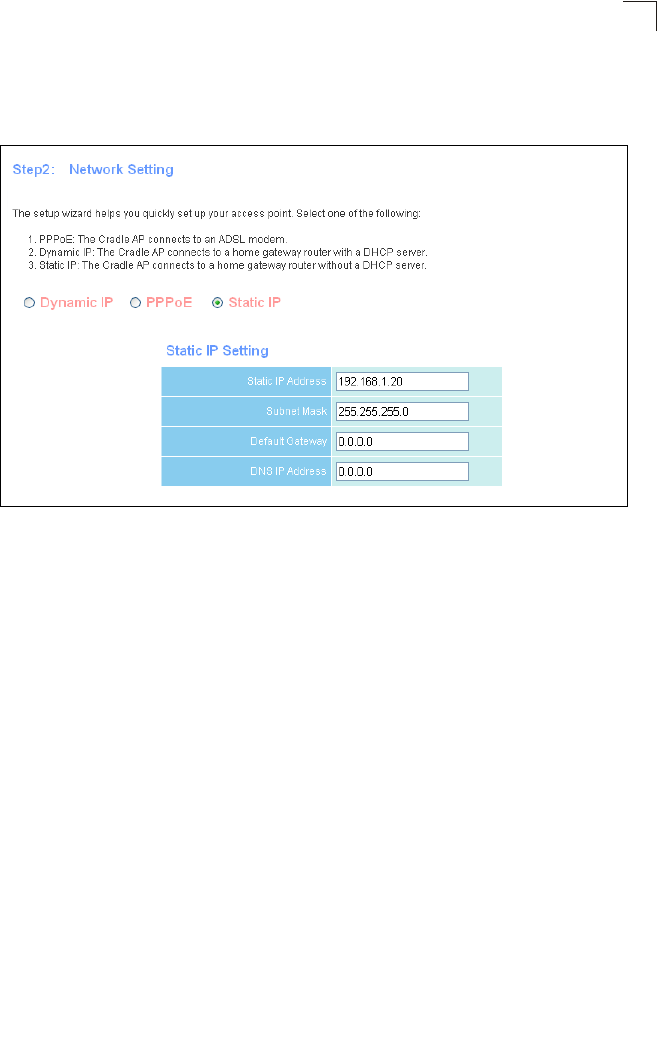
Using the Setup Wizard
1-5
1
3. Network Setting – Sets the access point’s IP address assignment method and
configures the local Dynamic Host Configuration Prototcol (DHCP) server and
Network Address Translation (NAT) settings.
Figure 1-6. Setup Wizard - Network Setting
There are three basic methods for configuring the access point’s IP address:
•Dynamic IP — The IP address is assigned automatically from a home
gateway router or other device that has a DHCP server feature.
•PPPoE — The IP address is assigned automatically from an Internet service
provider (ISP) through an ADSL modem using Point-to-Point Protocol over
Ethernet (PPPoE). If your ISP has provided you with a user name and
password, enter these in the corresponding text boxes under PPPoE Setting.
•Static IP — The IP address is assigned manually by the user. This may be
required if your access point is connected to a home gateway router or other
device that does not support a DHCP server.
If you select Static IP, enter an appropriate IP address and subnet mask that are
compatible with your existing network. If a management station exists on
another network segment, then you must enter the IP address for a Default
Gateway that can route traffic between these segments. Also enter the IP
address for the Domain Name Server (DNS) to be used for host-name to IP
address resolution.

Initial Configuration
1-6
1
Figure 1-7. Setup Wizard - DHCP Server and NAT Settings
DHCP Server/NAT Setting — This access point includes a DHCP server that
can assign IP addresses to any wireless station or Wi-Fi phone requesting the
service. Addresses are assigned from a common address pool configured on
the access point. You can configure the address pool by specifying start and
end IP addresses.
NAT is a standard method of mapping multiple “internal” IP addresses to one
“external” IP address on devices at the edge of a network. For the access point,
the internal (local) IP addresses are the IP addresses assigned to wireless
clients by the DHCP server, and the external IP address is the IP address
assigned to the access point itself. Note that the access point IP address is
always in a different subnet from the DHCP server pool. The access point uses
the NAT IP settings to route traffic from the wireless interface to the Ethernet
network.
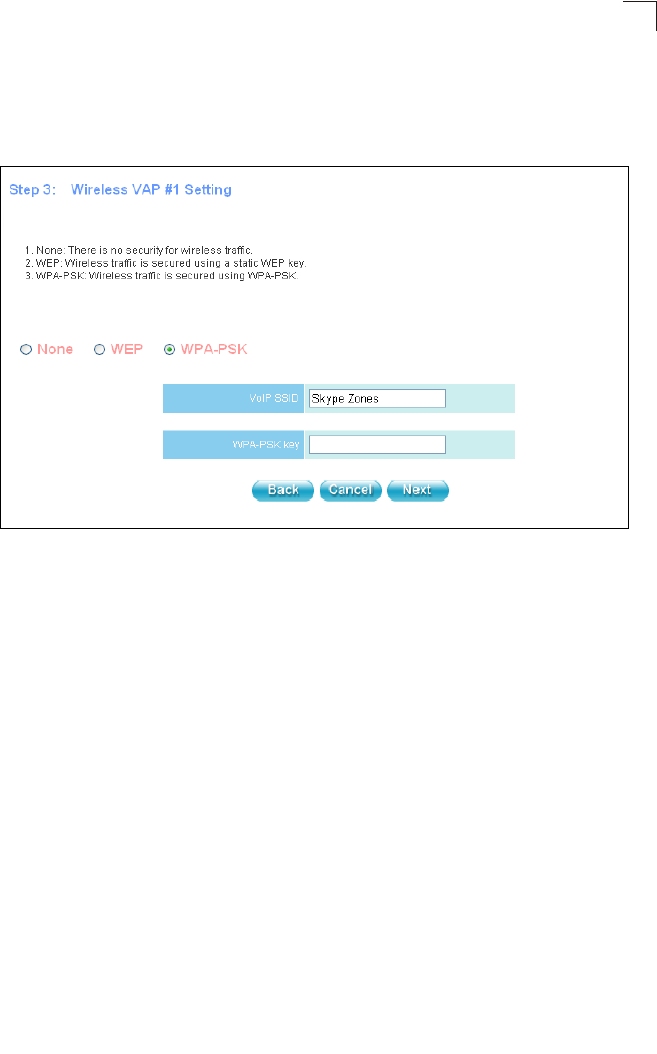
Using the Setup Wizard
1-7
1
4. Wireless VAP #1 Setting – Sets the wireless Service Set Identifier (SSID) and
wireless security encryption key for the VAP#1 network. Note that it is
recommended to restrict one VAP network for only Wi-Fi phones and let all
other wireless stations use the other VAP network.
Figure 1-8. Setup Wizard - Setting the VAP#1 SSID and Security
Enter the SSID, or wireless network name, which all wireless stations must use
to associate with the access point. The SSID is case sensitive and can consist
of up to 32 alphanumeric characters (Default: Skype Zones).
The access point offers two wireless security options; Wired Equivalent Privacy
(WEP) or Wi-Fi Protected Access Pre-shared Key (WPA-PSK). Select the
security you want to use and enter the appropriate encryption key, or select
“none” for no security.
•WEP Key — Enter 10 hexadecimal digits (0 to 9 and A to F) or 5
alphanumeric characters for 64 bit keys, 26 hexadecimal digits or 13
alphanumeric characters for 128 bit keys, and 32 hexadecimal digits or 16
alphanumeric characters for 152 bit keys.
•WPA-PSK Key — Enter as an easy-to-remember form of letters and
numbers. The key must be from 8 to 63 characters, which can include
spaces.
Note: All wireless devices must be configured with the same WEP or WPA-PSK Key
values to communicate with the access point.

Initial Configuration
1-8
1
5. Wireless VAP #2 Setting – Sets the wireless Service Set Identifier (SSID) and
wireless security encryption key for the VAP#2 wireless network.
Figure 1-9. Setup Wizard - Setting the VAP#2 SSID and Security
Enter the SSID, or wireless network name, which all wireless stations must use
to associate with the access point. The SSID is case sensitive and can consist
of up to 32 alphanumeric characters (Default: Wireless Network - 1).
The access point offers two wireless security options; Wired Equivalent Privacy
(WEP) or Wi-Fi Protected Access Pre-shared Key (WPA-PSK). Select the
security you want to use and enter the appropriate encryption key, or select
“none” for no security.
•WEP Key — Enter 10 hexadecimal digits (0 to 9 and A to F) or 5
alphanumeric characters for 64 bit keys, 26 hexadecimal digits or 13
alphanumeric characters for 128 bit keys, and 32 hexadecimal digits or 16
alphanumeric characters for 152 bit keys.
•WPA-PSK Key — Enter as an easy-to-remember form of letters and
numbers. The key must be from 8 to 63 characters, which can include
spaces.
Note: All wireless devices must be configured with the same WEP or WPA-PSK Key
values to communicate with the access point.

Using the Setup Wizard
1-9
1
6. Click Finish.
Figure 1-10. Setup Wizard - Finish
7. Click the Reboot button to restart the access point.
Note that the access point will start using any configured new IP settings, which
must be used to access the web management interface.

Initial Configuration
1-10
1
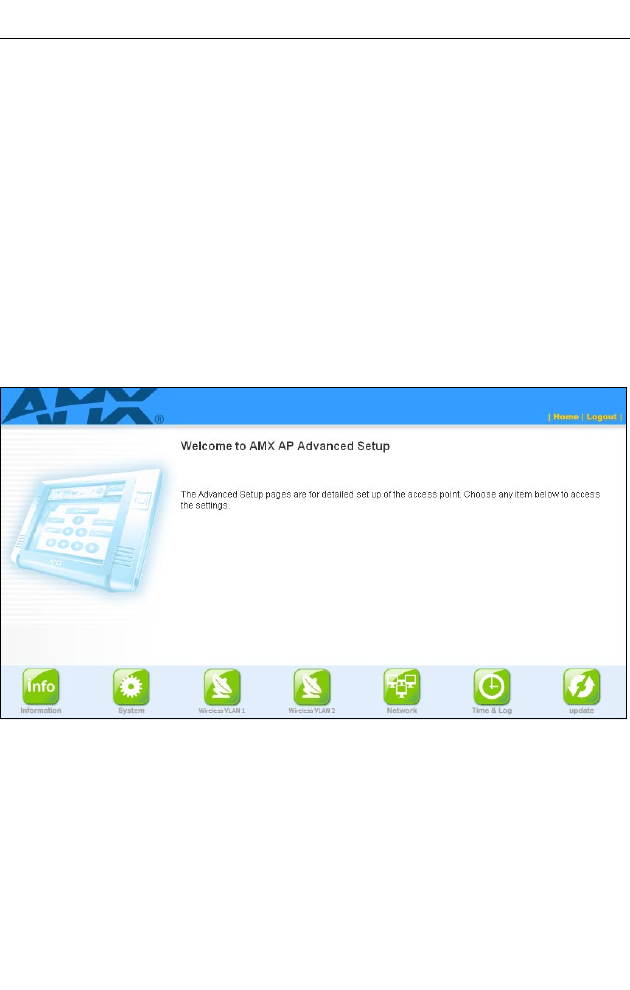
2-1
Chapter 2: System Configuration
The access point’s basic settings can be configured using the Setup Wizard, as
described in the previous chapter, “Initial Configuration.” However, for some
installations, you may need to configure specific settings that are not available in the
Setup Wizard. The Advanced Setup menu provides access to all the unit’s settings
for complete control of the access point’s features.
To access the Advanced Setup menus, follow these steps:
1. Use your web browser to connect to the management interface using the
default IP address of 192.168.1.20 or the IP address set through the Wizard.
2. Log into the access point management interface by leaving the password blank
(the default), and click “LOGIN.”
3. When the home page displays, click on Advanced Setup. The following page
displays.
Figure 2-1. Advanced Setup
The information in this chapter is organized to reflect the structure of the web
management screens for easy reference. However, it is recommended that you first
configure a password to control access to the management interface. For details,
see “Administration” on page 2-7.

System Configuration
2-2
2
The Advanced Setup pages include the options in the table below. For details on
configuration for each feature, see the corresponding page number.
Table 2-1. Configuration Options
Menu Description Page
Information
System Displays a summary of access point settings 2-3
Client Displays information on stations associated to the access
point
2-4
Network Displays DHCP client, server, NAT, and PPPoE settings 2-5
Event Log Displays the system message log 2-6
System
Administration Configures the password for management
access
2-7
Operation Sets the device function 2-8
Reboot System Restarts the system and resets configuration settings to
factory defaults
2-8
Wireless VAP 1, 2
Basic Enables the VAP interface and sets the SSID 2-10
Channel Sets the radio channel 2-11
WEP Configures WEP security 2-11
WPA-PSK Configures WPA-PSK security 2-12
Network
DHCP Client Enables DHCP client or manually sets an IP address 2-14
DHCP Server/NAT Enables DHCP server and configures NAT settings 2-15
PPPoE Configures PPPoE settings 2-17
Time & Log
SNTP Sets the system clock using SNTP 2-18
Update
Upgrade via the Web
Page
Upgrades system software from a local file
2-20
Upgrade via a Remote
Server
Upgrades system software from a file on an FTP or TFTP
server
2-20
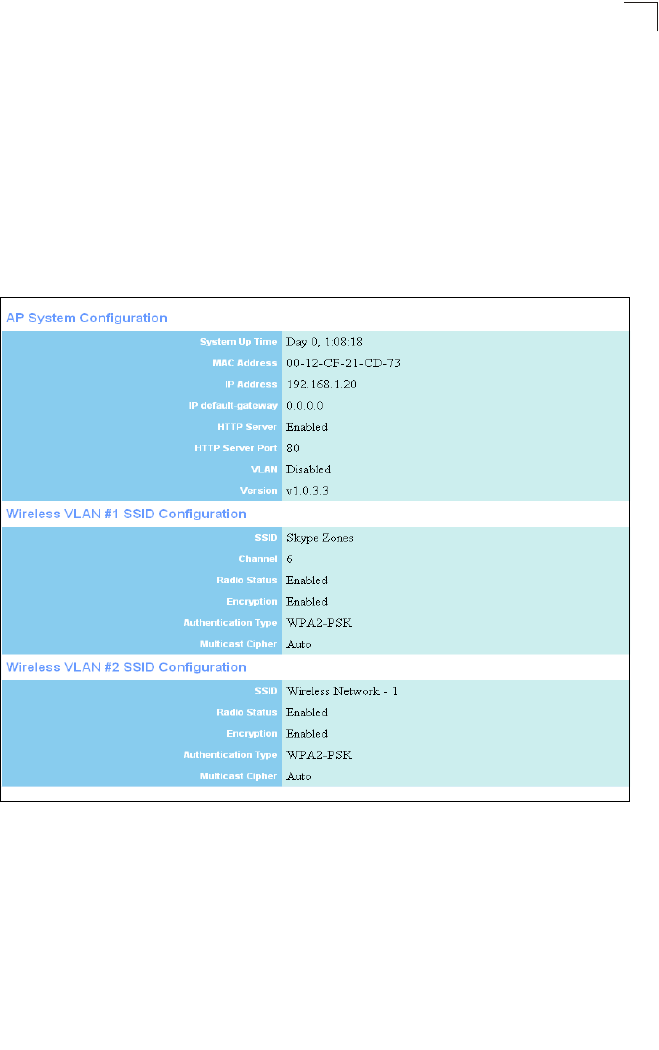
Information
2-3
2
Information
The system information pages display details on the current configuration and status
of the access point, including associated wireless stations and event log messages.
System
The system information page displays basic system configuration settings, as well
as the settings for each wireless interface. The displayed settings are for status
information only and are not configurable on this page.
Figure 2-2. System Information
The displayed items on this page can be described as follows:
AP System Configuration – Displays basic system configuration settings:
•System Up Time – Length of time since the access point was powered on.
•MAC Address – The physical layer address for the access point’s Ethernet port.
•IP Address – The IP address configured on the access point.
•IP Default Gateway – The IP address of the gateway router between the access
point and management stations that exist on other network segments.

System Configuration
2-4
2
•HTTP Server – The status of the web management server.
•HTTP Server Port – The TCP port used by the web management server.
•Version – The version number of the current access point software.
Wireless Data #1/#2 SSID Configuration – The AP Wireless Configuration table
displays the wireless interface settings listed below.
•SSID – The service set identifier for this wireless group.
•Channel – The radio channel through which the access point communicates with
wireless clients.
•Encryption – The key size used for data encryption.
•Authentication Type – Shows if open system or shared key authentication is
used.
•Multicast Cipher – The encryption used for broadcast and multicast data.
Client
The client information page displays details on wireless devices currently associated
to the access point. The displayed settings are for status information only and are
not configurable on this page.
Figure 2-3. Client Information
The displayed items on this page can be described as follows:
•Station Address – The MAC address of the wireless client.
•Authenticated – Shows if the client has been authenticated. The two basic
methods of authentication supported for 802.11 wireless networks are “open
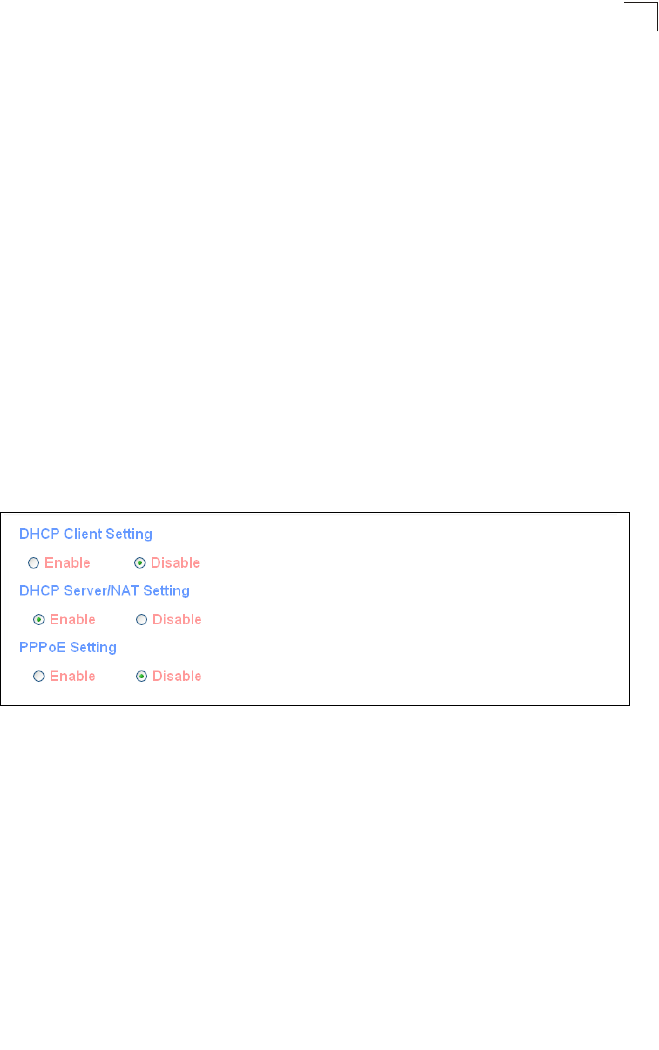
Information
2-5
2
system” and “shared key.” Open-system authentication accepts any client
attempting to connect to the access point without verifying its identity. The
shared-key approach uses Wired Equivalent Privacy (WEP) to verify client identity
by distributing a shared key to clients before attempting authentication.
•Associated – Shows if the client has been successfully associated with the access
point. Clients can associate with the access point only after authentication has
completed.
•Encryption – Indicates if encryption is being used by the client; either Enabled or
Disabled.
•Cipher – Indicates the encryption cipher capability being advertised by the client;
WEP, TKIP, AES, or None.
•SSID -- The VAP interface that the client is associated with.
•RSSI -- The received signal strength of the client.
Network
The network information page displays the current Dynamic Host Configuration
Protocol (DHCP) client, DHCP server, and Point-to-Point Protocol over Ethernet
(PPPoE) status. The basic settings are also configurable on this page.
Figure 2-4. Network Information
The displayed items on this page can be described as follows:
•DHCP Client Setting – Enables the access point to automatically obtain an IP
address from a DHCP server. When disabled, or if a response is not received from
the DHCP server, the access point uses the configured static IP settings on the
Network > DHCP Client page. (Default: Disabled)
•DHCP Server/NAT Setting – Enables or disables the DHCP server on the access
point. The access point DHCP server can assign IP addresses to any wireless
client requesting the service. Addresses are assigned to clients from a common
address pool configured on the Network > DHCP Server/NAT page.
(Default: Enabled)
•PPPoE Setting – Enables a connection to an Internet service provider using
PPPoE. The PPPoE access user name and password can be set on the
Network > PPPoE page. (Default: Disabled)
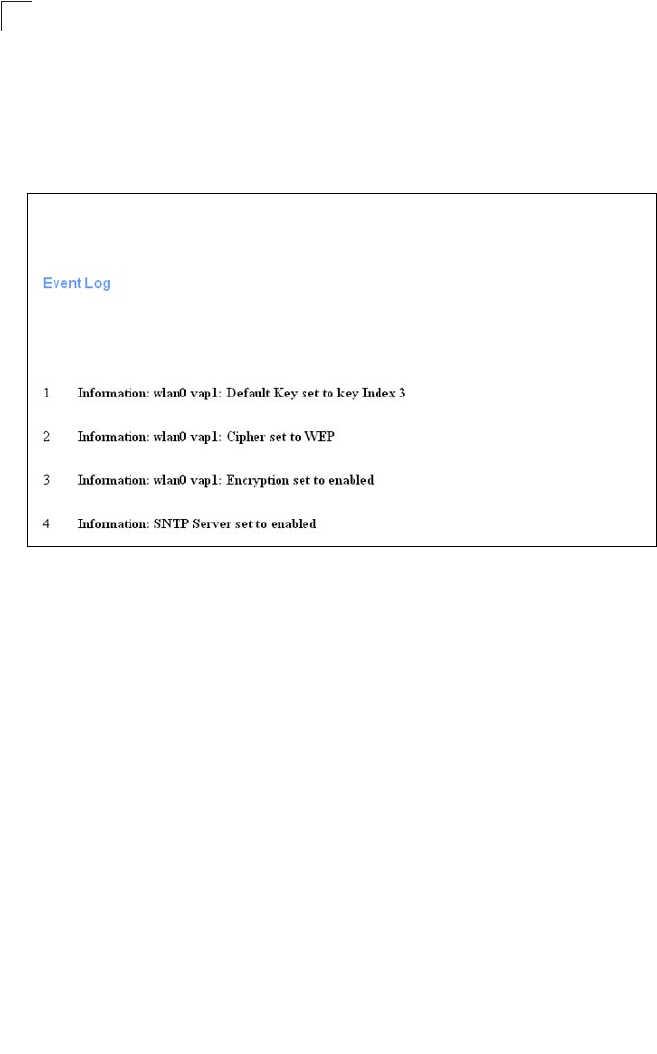
System Configuration
2-6
2
Event Log
The Event Log page displays system messages generated during system operation.
The logged messages can serve as a valuable tool for isolating access point and
network problems.
Figure 2-5. Event Log
The Event Log page displays the last 128 messages logged in chronological order, from
the newest to the oldest. Log messages saved in the access point’s memory are erased
when the device is rebooted.
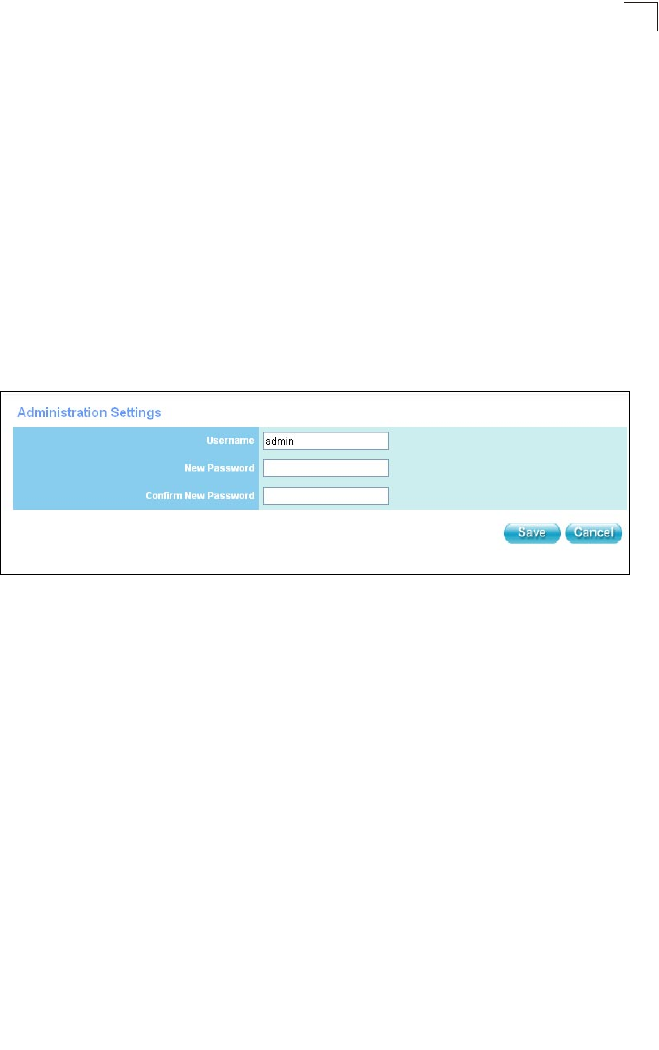
System Settings
2-7
2
System Settings
The system settings pages allow you to change the management access password
and restart the access point.
Administration
Management access to the access point is controlled through a single password.
To protect access to the management interface, you need to configure an
Administrator password as soon as possible. If the password is not configured, then
anyone having access to the access point may be able to compromise access point
and network security.
Note: Pressing the reset button on the back of the access point for more than five
seconds resets the user name and password to the factory defaults.
Figure 2-6. Administration Password
The displayed items on this page can be described as follows:
•Username – The name of the user. The default name is “admin.” The user name
is not configurable.
•New Password – The password for management access. (Length: 0-32
characters, case sensitive)
•Confirm New Password – Enter the password again for verification.

System Configuration
2-8
2
Operation Mode
The device can be set as an access point, a wireless repeater or a wireless bridge
according to user’s need.
Figure 2-7. Administration Password
There are three operation modes:
•AP — Set the device as an Access Point.
•Repeater — Set the device as a Wireless Repeater to relay messages between
subnetworks that use different protocols or cable types. The Root AP MAC
Address can be assigned manually or selected after click “Scan”.
•Bridge — Set the device as a Wireless Bridge to connect two local-area networks
(LANs), or two segments of the same LAN that use the same protocol. The Bridge
Nodes need to be assigned manually by the user.
Reboot System
The Reboot System page allows you to restart the access point software and restore
factory default settings.
Figure 2-8. Reboot System

System Settings
2-9
2
The displayed items on this page can be described as follows:
•Restore Factory Settings – Click the Restore button to reset the configuration
settings for the access point to the factory defaults and reboot the system. Note
that all user configured information will be lost. You will have to use the default IP
address to re-gain management access to the access point.
•Reboot Access Point – Click the Reboot button to reboot the system.
Note: If you have upgraded the system software, then you must reboot the access point
to implement the new code.

System Configuration
2-10
2
Wireless VAP Settings
The Wireless VAP #1 Setting and Wireless VAP #2 Setting pages include
configuration options for radio signal characteristics and wireless security features
on the access point.
The following sections apply to both Wireless VAP #1 Setting and Wireless VAP #2
Setting pages.
Note: it is recommended to restrict one VAP network for only Wi-Fi phones and let all
other wireless stations use the other VAP network.
Basic
The Basic Setting page allows you to enable the VAP radio interface and define the
Service Set IDentifier (SSID).
The access point includes an IEEE 802.11g radio for wireless communications. The
IEEE 802.11g standard operates within the 2.4 GHz band at up to 54 Mbps. Note
that because the IEEE 802.11g standard is an extension of the IEEE 802.11b
standard, it allows clients with 802.11b wireless network cards to associate to an
802.11g access point.
The SSID is a recognizable text string that identifies the wireless network service
provided by the VAP interface. Wireless clients that want to connect to the network
must set their SSIDs to match that of the VAP interface.
Figure 2-9. Basic Wireless Settings
The displayed items on this page can be described as follows:
•Radio Status – Enables radio communications for the VAP interface.
(Default: Enabled)
•SSID – The name of the wireless network service provided by the VAP. Clients that
want to connect to the network must set their SSID to the same as that of the VAP
interface. (Defaults: Skype Zones,” VAP #2 “Wireless Network - 1”; Range: 1-32
characters)

Wireless VAP Settings
2-11
2
Channel Setting
The access point uses one radio channel in the 2.4 GHz band to communicate with its
clients. The radio channel may be set manually by the user or automatically by the
system, which selects the channel with the least radio interference.
Note: If you experience poor performance, you may be encountering interference from
another wireless device. Try changing the channel, as this may eliminate
interference and increase performance. Channels 1, 6, and 11, as the three
non-overlapping channels in the 2.4 GHz band, are preferred.
Figure 2-10. Wireless Channel Setting
The displayed items on this page can be described as follows:
•Auto Channel Selection – Enables the access point to automatically select an
interference-free radio channel. (Default: Disabled)
•Radio Channel – The radio channel that the access point uses to communicate
with wireless clients. When multiple access points are deployed in the same area,
set the channel on neighboring access points at least five channels apart to avoid
interference with each other. For example, you can deploy up to three access
points in the same area using channels 1, 6, 11. Note that wireless clients
automatically set the channel to the same as that used by the access point to which
it is linked. (Range: 1-11; Default: 6)
WEP Security
The access point is configured by default as an “open system,” which broadcasts a
beacon signal including the configured SSID. Wireless clients with a configured
SSID of “any” can read the SSID from the beacon and automatically set their SSID
to allow immediate connection to the access point. To secure the wireless network,
you have to implement user authentication and wireless data encryption.
Wired Equivalent Privacy (WEP) provides a basic level of security, preventing
unauthorized access to the network and encrypting data transmitted between
wireless clients and the access point. WEP uses static shared keys (fixed-length
hexadecimal or alphanumeric strings) that are manually distributed to all clients that
want to use the network.

System Configuration
2-12
2
Figure 2-11. WEP Wireless Security
The displayed items on this page can be described as follows:
•WEP Status – Enables the access point to use WEP shared keys. If enabled, you
must configure at least one key for the VAP interface and all its clients.
•Key Type – Select the preferred method of entering WEP encryption keys on the
access point.
-Hexadecimal: Enter keys as hexadecimal digits (0 to 9 and A to F).
-Alphanumeric: Enter keys as alphanumeric characters.
•Setting Key – Sets WEP key values for one or two keys. At least one key must be
specified. Each WEP key has an index number. Index numbers 1 and 2 apply to
VAP #1 interface and numbers 3 and 4 apply to VAP #2 interface. The selected key
is used for authentication and encryption on the VAP interface.
Enter key values that match the key type and length settings. Select 64 Bit, 128 Bit,
or 152 Bit key length. Note that the same size of encryption key must be supported
on all wireless clients. (Default: 64 Bit)
-64 Bit: Enter keys as 5 alphanumeric characters or 10 hexadecimal digits.
-128 Bit: Enter keys as 13 alphanumeric characters or 26 hexadecimal digits.
-152 Bit: Enter keys as 16 alphanumeric characters or 32 hexadecimal digits.
Note: Key index and type must match that configured on all clients.
WPA-PSK Security
Wi-Fi Protected Access (WPA) employs a combination of technologies to provide an
enhanced security solution for wireless networks. The WPA Pre-shared Key
(WPA-PSK) mode for small networks uses a common password phrase that must be
manually distributed to all clients that want to connect to the network.
WPA2 is a futher security enhancement that includes the now ratified IEEE 802.11i
wireless security standard. Both WPA and WPA2 provide very robust security
through the support of the Advanced Encryption Standard (AES) and Temporal Key
Integrity Protocol (TKIP) encryption ciphers.

Wireless VAP Settings
2-13
2
Note: The computationally intensive operations of AES encryption requires hardware
support on client devices. Before implementing AES in the network, be sure that
wireless client hardware is AES or WPA2 compliant.
Figure 2-12. WPA-PSK Wireless Security
The displayed items on this page can be described as follows:
•WPA-PSK Status – Enables WPA-PSK or WPA2-PSK security on the VAP
interface. When enabled, WEP clients are not supported. (Default: Enabled).
•Authentication – Selects WPA-PSK or WPA2-PSK security.
•Key Cipher Mode – Selects the encryption cipher to use for multicast and unicast
data traffic:
-Auto – Uses TKIP for the multicast cipher and TKIP or AES for the unicast cipher
depending on the capability of associated clients.
-AES – Uses AES keys for both multicast and unicast encryption.
-TKIP – Uses TKIP keys for both multicast and unicast encryption.
•WPA-PSK Key – Enter a key as an easy-to-remember form of letters and
numbers. The key must be from 8 to 63 characters, which can include spaces. All
wireless clients must be configured with the same key to communicate with the
VAP interface.
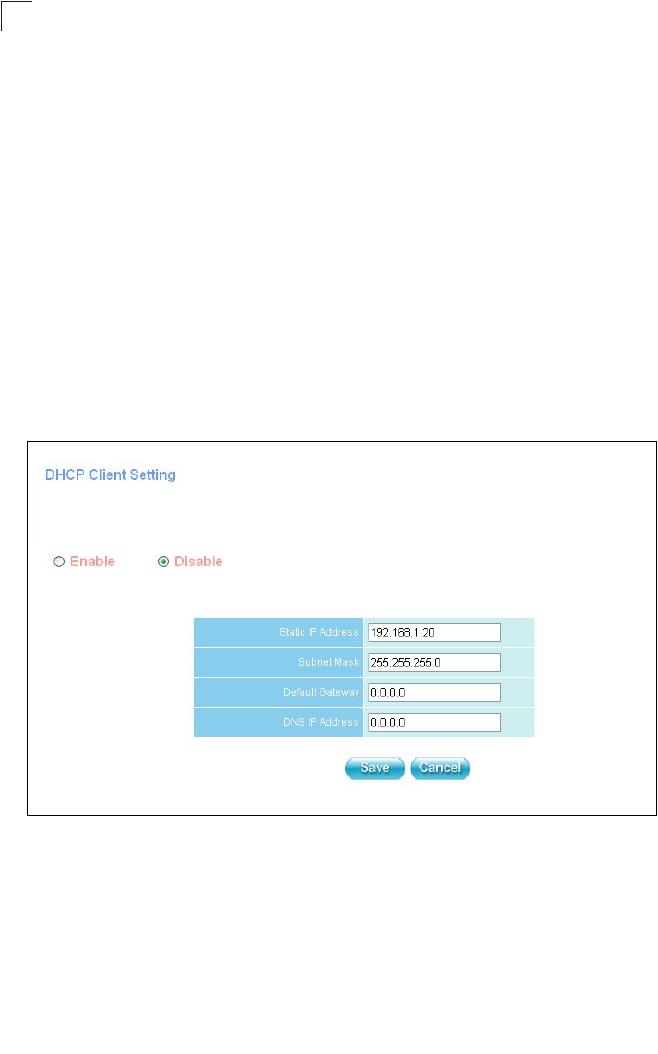
System Configuration
2-14
2
Network Settings
The access point supports DHCP client, DHCP server and Network Address
Translation (NAT). Point-to-Point Protocol over Ethernet (PPPoE) is also supported
for users that have an IP address assigned automatically from an Internet service
provider (ISP) through an ADSL modem.
DHCP Client
Configuring the access point with an IP address enables you to manage the access
point from any PC in the attached network. A number of access point features
depend on IP addressing to operate.
Note: You can connect to the web browser interface to access IP addressing only if the
access point already has an IP address that is reachable through your network.
By default, the access point is configured with the IP address 192.168.1.20, with the
DHCP client disabled.
Figure 2-13. DHCP Client Settings
The displayed items on this page can be described as follows:
•DHCP Client Setting – Enables the access point to automatically obtain an IP
address from a DHCP server. If a response is not received from the DHCP server,
the access point uses the fixed IP settings as configured on this page. When set to
disabled, a static IP address can be manually configured.
•Static IP Address – The IP address of the access point. Valid IP addresses
consist of four decimal numbers, 0 to 255, separated by periods.

Network Settings
2-15
2
•Subnet Mask – The mask that identifies the host address bits used for routing to
specific subnets.
•Default Gateway – The default gateway is the IP address of the router for the
access point, which is used if the requested destination address is not on the local
subnet. If you have management stations located on another subnet, type the IP
address of the default gateway router in the text field provided. Otherwise, leave
the address as all zeros (0.0.0.0).
•DNS IP Address – The IP address of a Domain Name Server on the network. A
DNS maps numerical IP addresses to domain names and can be used to identify
network hosts by familiar names instead of the IP addresses.
If you have a DNS server located on the local network, type the IP address in the
text field provided. Otherwise, leave the address as all zeros (0.0.0.0).
DHCP Server/NAT
The access point includes a Dynamic Host Configuration Protocol (DHCP) server
that can assign temporary IP addresses to wireless clients requesting the service.
Addresses are assigned to clients from a common address pool configured on the
access point. Configure an address pool by specifying start and end IP addresses.
Be sure not to include the access point's IP address in the address pool range.
Network Address Translation (NAT) is a standard method of mapping multiple
"internal" IP addresses to one "external" IP address on devices at the edge of a
network. For the access point, the internal (local) IP addresses are the IP addresses
assigned to wireless clients by the DHCP server, and the external IP address is the
IP address assigned to the Ethernet port. When enabled, the access point's wireless
interface uses the NAT IP settings to access the Ethernet network.
Note: When the DHCP server is enabled, NAT is also enabled.

System Configuration
2-16
2
Figure 2-14. DHCP Server/NAT Settings
The displayed items on this page can be described as follows:
•DHCP Server/NAT Setting – Enables or disables the DHCP server and NAT on
the access point. (Default: Enabled)
•Start/End IP Address – Specifies the start/end IP address of a range that the
DHCP server can assign to DHCP clients. You can specify a single address or an
address range.
•Gateway – The IP address of the gateway router for the access point, which is
used if the requested destination address is not on the local subnet.
•DNS IP Address – The IP address of a Domain Name Server on the network. A
DNS maps numerical IP addresses to domain names and can be used to identify
network hosts by familiar names instead of the IP addresses.

Network Settings
2-17
2
PPPoE
Many Internet service providers (ISPs) use the Point-to-Point Protocol over Ethernet
(PPPoE) to automatically assign an IP address to users with a DSL modem. The
PPPoE page provides the settings needed for this service.
Figure 2-15. PPPoE Settings
The displayed items on this page can be described as follows:
•PPPoE Setting — Enables the access point IP address to be assigned
automatically from an Internet service provider (ISP) through an ADSL modem
using PPPoE.
•Username — If your ISP has provided you with a PPPoE user name, enter it in the
corresponding text box.
•Password — If your ISP has provided you with a PPPoE password, enter it in the
corresponding text box.
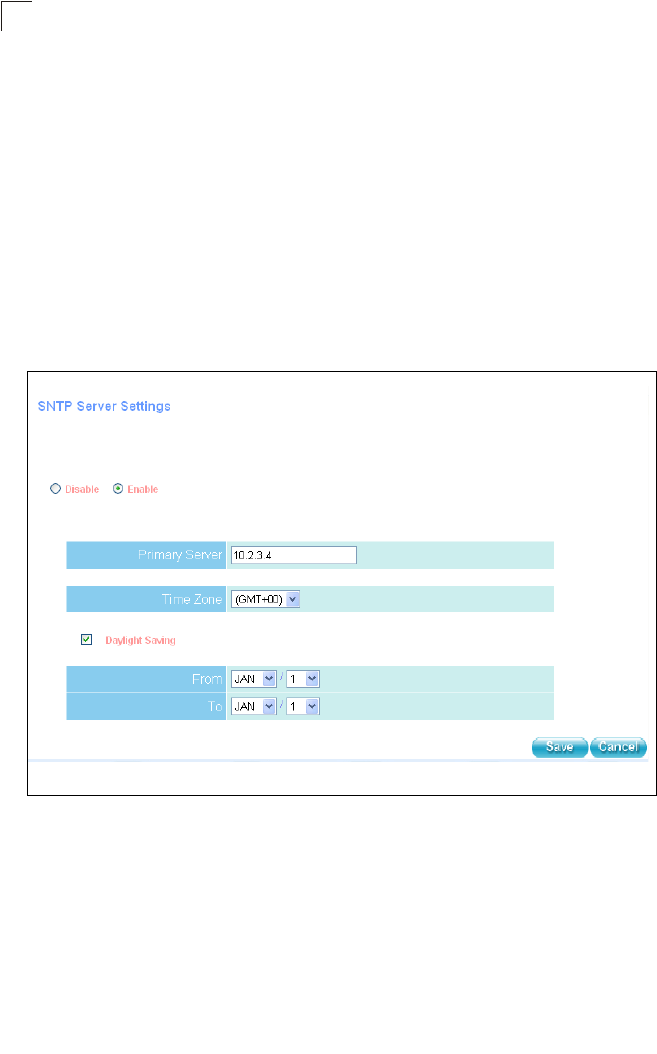
System Configuration
2-18
2
Time and Log
Simple Network Time Protocol (SNTP) allows the access point to set its internal
clock based on periodic updates from a time server (SNTP or NTP). Maintaining an
accurate time on the access point enables all system log messages to be stamped
with the correct time and date. If the clock is not set, the access point only records
the time from the factory default set at the last bootup.
The access point acts as an SNTP client, which periodically sends time
synchronization requests to a specific time server. SNTP uses Coordinated
Universal Time (or UTC, formerly Greenwich Mean Time, or GMT) based on the
time at the Earth’s prime meridian, zero degrees longitude. To display the time
corresponding to your local time, you must also indicate the number of hours your
time zone is located before or after UTC/GMT.
Figure 2-16. SNTP Settings
The displayed items on this page can be described as follows:
•SNTP Server Setting — Configures the access point to operate as an SNTP client.
When enabled, the time server IP address must be specified.
•Primary Server: The IP address of an SNTP or NTP time server that the access
point attempts to poll for a time update.
•Time Zone — Sets the number of hours your local time zone is located before or
after UTC/GMT. (Default: GMT+00)

Time and Log
2-19
2
•Daylight Saving — The access point provides a way to automatically adjust the
system clock for Daylight Savings Time changes. To use this feature you must
define the month and date to begin and to end the change from standard time.
During this period the system clock is set back by one hour.

System Configuration
2-20
2
Updating Firmware
You can upgrade new access point software from a local file on the management
workstation, or from an FTP or TFTP server.
After upgrading to new software, you must reboot the access point to implement the
new code. Until a reboot occurs, the access point will continue to run the software it
was using before the upgrade started.
Upgrade via the Web Page
This web page allows you to download a new software code file from the local web
management station to the access point using HTTP.
Figure 2-17. Web Page Upgrade
The displayed items on this page can be described as follows:
•New Firmware File — Specifies the name of the code file on the local web
management station. You can use the Browse button to locate the image file locally
on the management station.
•Start Upgrade — Starts the download process. Be sure to allow enough time for
the download to complete before rebooting the access point.
Upgrade via a Remote Server
This web page allows you to download a new software code file from a remote
server to the access point using FTP or TFTP.
When using an FTP or TFTP server, be sure to first obtain the IP address of the
server and note the correct file path where the access point software is stored. If
upgrading from an FTP server, also make sure that you have a user account
configured on the server with a user name and password.

Updating Firmware
2-21
2
Figure 2-18. Remote Server Upgrade
The displayed items on this page can be described as follows:
•Remote File — Specifies a software code file download from a remote FTP or
TFTP server.
•New firmware file — Specifies the name of the code file on the server. A path on
the server can be specified using “/” in the destination file name, providing the path
already exists. Other than to indicate a path, the file name must not contain any
slashes (\ or /), the leading letter cannot be a period (.), and the maximum length
for file names on the FTP/TFTP server is 255 characters or 32 characters for files
on the access point. (Valid characters: A-Z, a-z, 0-9, “.”, “-”, “_”)
•IP Address — IP address or host name of the FTP or TFTP server.
•Username — The user ID used for login to an FTP server.
•Password — The password used for login to an FTP server.
•Start Upgrade — Starts the download process. Be sure to allow enough time for
the download to complete before rebooting the access point.
Note: When you have downloaded the software file, you must reboot the access point to
implement the new code.

System Configuration
2-22
2

A-1
Appendix A: Troubleshooting
Check the following items before you contact local Technical Support.
1. If wireless clients cannot access the network, check the following:
• Be sure the access point and the wireless clients are configured with the same
Service Set ID (SSID).
• If authentication or encryption are enabled, ensure that the wireless clients are
properly configured with the appropriate authentication or encryption keys.
2. If the access point cannot be configured using a web browser:
• Be sure to have configured the access point with a valid IP address, subnet
mask and default gateway.
• If you are connecting to the access point through the wired Ethernet interface,
check the network cabling between the management station and the access
point. If you are connecting to access point from a wireless client, ensure that
you have a valid connection to the access point.
3. If you forgot or lost the password:
• Set the access point to its default configuration by pressing the reset button
on the back panel for 5 seconds or more. Connect to the web management
interface using the default IP address 192.168.1.20. Then use the default user
name “admin” and a null password to access the management interface.
4. If all other recovery measure fail, and the access point is still not functioning
properly, take any of these steps:
• Reset the access point’s hardware using the web interface or through a power
reset.
• Reset the access point to its default configuration by pressing the reset button
on the back panel for 5 seconds or more. Connect to the web management
interface using the default IP address 192.168.1.20, then use the default user
name “admin” and a null password.

Troubleshooting
A-2
A

Glossary-1
Glossary
10BASE-T
IEEE 802.3 specification for 10 Mbps Ethernet over two pairs of Category 3 or better
UTP cable.
100BASE-TX
IEEE 802.3u specification for 100 Mbps Fast Ethernet over two pairs of Category 5
or better UTP cable.
Access Point
An internetworking device that seamlessly connects wired and wireless networks.
Access points attached to a wired network, support the creation of multiple radio
cells that enable roaming throughout a facility.
Ad Hoc
A group of computers connected as an independent wireless network, without an
access point.
Advanced Encryption Standard (AES)
An encryption algorithm that implements symmetric key cryptography. AES provides
very strong encryption using a completely different ciphering algorithm to TKIP and
WEP.
Authentication
The process to verify the identity of a client requesting network access. IEEE 802.11
specifies two forms of authentication: open system and shared key.
Backbone
The core infrastructure of a network. The portion of the network that transports
information from one central location to another central location where it is unloaded
onto a local system.
Beacon
A signal periodically transmitted from the access point that is used to identify the
service set, and to maintain contact with wireless clients.
Broadcast Key
Broadcast keys are sent to stations using dynamic keying. Dynamic broadcast key
rotation is often used to allow the access point to generate a random group key and
periodically update all key-management capable wireless clients.

Glossary
Glossary-2
Dynamic Host Configuration Protocol (DHCP)
Provides a framework for passing configuration information to hosts on a TCP/IP
network. DHCP is based on the Bootstrap Protocol (BOOTP), adding the capability
of automatic allocation of reusable network addresses and additional configuration
options.
Encryption
Data passing between the access point and clients can use encryption to protect
from interception and evesdropping.
Ethernet
A popular local area data communications network, which accepts transmission
from computers and terminals.
File Transfer Protocol (FTP)
A TCP/IP protocol used for file transfer.
Hypertext Transfer Protocol (HTTP)
HTTP is a standard used to transmit and receive all data over the World Wide Web.
IEEE 802.11b
A wireless standard that supports wireless communications in the 2.4 GHz band
using Direct Sequence Spread Spectrum (DSSS). The standard provides for data
rates of 1, 2, 5.5, and 11 Mbps.
IEEE 802.11g
A wireless standard that supports wireless communications in the 2.4 GHz band
using using Orthogonal Frequency Division Multiplexing (OFDM). The standard
provides for data rates of 6, 9, 11, 12, 18, 24, 36, 48, 54 Mbps. IEEE 802.11g is also
backward compatible with IEEE 802.11b.
Infrastructure
An integrated wireless and wired LAN is called an infrastructure configuration.
Local Area Network (LAN)
A group of interconnected computer and support devices.
MAC Address
The physical layer address used to uniquely identify network nodes.
Network Time Protocol (NTP)
NTP provides the mechanisms to synchronize time across the network. The time
servers operate in a hierarchical-master-slave configuration in order to synchronize
local clocks within the subnet and to national time standards via wire or radio.

Glossary-3
Glossary
Open System
A security option which broadcasts a beacon signal including the access point’s
configured SSID. Wireless clients can read the SSID from the beacon, and
automatically reset their SSID to allow immediate connection to the nearest access
point.
Orthogonal Frequency Division Multiplexing (ODFM)
OFDM/ allows multiple users to transmit in an allocated band by dividing the
bandwidth into many narrow bandwidth carriers.
Service Set Identifier (SSID)
An identifier that is attached to packets sent over the wireless LAN and functions as
a password for joining a particular radio cell; i.e., Basic Service Set (BSS).
Session Key
Session keys are unique to each client, and are used to authenticate a client
connection, and correlate traffic passing between a specific client and the access
point.
Shared Key
A shared key can be used to authenticate each client attached to a wireless network.
Shared Key authentication must be used along with the 802.11 Wireless Equivalent
Privacy algorithm.
Simple Network Time Protocol (SNTP)
SNTP allows a device to set its internal clock based on periodic updates from a
Network Time Protocol (NTP) server. Updates can be requested from a specific NTP
server, or can be received via broadcasts sent by NTP servers.
Temporal Key Integrity Protocol (TKIP)
A data encryption method designed as a replacement for WEP. TKIP avoids the
problems of WEP static keys by dynamically changing data encryption keys.
Trivial File Transfer Protocol (TFTP)
A TCP/IP protocol commonly used for software downloads.
Wi-Fi Protected Access
WPA employs 802.1X as its basic framework for user authentication and dynamic
key management to provide an enhanced security solution for 802.11 wireless
networks.

Glossary
Glossary-4
Wired Equivalent Privacy (WEP)
WEP is based on the use of security keys and the popular RC4 encryption
algorithm. Wireless devices without a valid WEP key will be excluded from network
traffic.
WPA Pre-shared Key (WPA-PSK)
WPA-PSK can be used for small office networks with a limited number of users that
may not need a high level of security. WPA-PSK provides a simple security
implementation that uses just a pre-shared password for network access.

Index-1
A
authentication
type 2-11
C
configuration settings, saving or
restoring 2-9
configuration, initial setup 1-1
D
DHCP 2-14
server 2-15
DNS 2-15, 2-16
Domain Name Server See DNS
downloading software 2-20
F
factory defaults
restoring 2-9
firmware
upgrading 2-20
G
gateway address 2-15, 2-16
I
IEEE 802.11g
configuring interface 2-10
radio channel 2-11
initial setup 1-1
IP address
configuring 1-5, 2-14
M
multicast cipher 2-13
O
open system 2-11
R
radio channel
802.11g interface 2-11
reset 2-9
reset button 2-9
resetting the access point 2-9
restarting the system 2-9
S
security, options 2-11
SNTP 2-18
enabling client 2-18
server 2-18
software
displaying version 2-3, 2-20
downloading 2-20
SSID
configuring 1-7, 1-8
system clock, setting 2-18
system software, downloading from
server 2-20
T
troubleshooting A-1
U
upgrading software 2-20
user name, manager 2-7
user password 2-7
W
WEP
configuring 2-11
WPA
pre-shared key 2-13
Index

Index
Index-2
SAP2315A
E062006-EK-R01
FEGFT2315000E

SAP2315A
802.11b/g Access Point
Quick Installation Guide
SAP2315A
E062006-EK-R01
FEGFT2315000E
INTRODUCTION
Package Checklist
The 802.11b/g Access Point package includes:
• Access Point
• One Category 5 network cable
• One AC power adapter
• This Installation Guide
• Management Guide CD
Inform your dealer if there are any incorrect, missing or damaged parts. If
possible, retain the carton, including the original packing materials. Use
them again to repack the product in case there is a need to return it.
Power Connector
The access point does not have a power switch. It is powered on when
connected to the AC power adapter, and the power adapter is connected
to a power source. The power adapter automatically adjusts to any
voltage between 100-240 volts at 50 or 60 Hz. No voltage range settings
are required.
Hardware Description
Ethernet LAN
RJ-45 Port
Power
Socket
Antenna
Reset Button
Top Panel Bottom Panel
LED Indicators
The access point includes three status LED indicators, as described in
the following figure and table.
LED Status Description
POWER On Green Indicates that the system is working normally.
WLAN On/Flashing Green Indicates the 802.11g radio is enabled and
transmitting or receiving data through wireless links.
The flashing rate is proportional to network activity.
Off Indicates the 802.11g radio is disabled.
ETHERNET On/Flashing Green Indicates a valid link on the Ethernet port and that the
access point is transmitting or receiving data. The
flashing rate is proportional to network activity.
Off The Ethernet port has no valid link.
Power
802.11g Wireless
Link/Activity
Ethernet Link/
Activity
INTRODUCTION
Ethernet Port
The access point has one 10BASE-T/100BASE-TX RJ-45 port that can be
attached directly to 10BASE-T/100BASE-TX LAN segments. These
segments must conform to the IEEE 802.3-2005 specifications.
This port supports automatic MDI/MDI-X operation, so you can use
straight-through cables for all network connections to PCs, switches, or
hubs.
Reset Button
The Reset button is used to restart the access point or restore the factory
default configuration. If you hold down the button for less than 5 seconds,
the access point will perform a hardware reset. If you hold down the
button for 5 seconds or more, any configuration changes you may have
made are removed, and the factory default configuration is restored to the
access point.
4. Observe the Indicator LEDs – When you power on the access
point verify that the POWER LED turns on and that the other LED
indicators start functioning as described under ”LED Indicators”.
5. Connect the Ethernet Cable – The access point can be
connected to any 10 or 100 Mbps Ethernet network device, such
as a hub or a switch. Connect your network to the RJ-45 port on
the back panel using category 3, 4, or 5 UTP Ethernet cable.
When the access point and the connected device are powered on,
the ETHERNET LED should turn on indicating a valid network
connection. If the ETHERNET LED fails to turn on, refer to
“Troubleshooting”.
Note: The RJ-45 port on the access point supports automatic MDI/MDI-X
operation, so you can use straight-through cables for all network
connections to PCs, switches, or hubs.
Access Point Configuration
The access point can be configured by connecting a PC to its Ethernet
port and accessing the web interface. The default IP address of the
access point is 192.168.1.20, with login user name “admin” and no
default password.
For more information, refer to the Management Guide.
To install the Access Point, follow these steps:
1. Select a Site – Choose a proper place for the access point. In
general, the best location is at the center of your wireless coverage
area, within line of sight of all wireless devices. For optimum
performance, consider these points:
• Mount the access point as high as possible above any obstructions
in the coverage area.
• Avoid mounting next to or near building support columns or other
obstructions that may cause reduced signal or null zones in parts of
the coverage area.
• Mount away from any signal absorbing or reflecting structures (such
as those containing metal).
• Avoid radio interference by mounting away from other 2.4 GHz
devices, such as other 802.11b or g wireless devices, regular
cordless phones, and microwave ovens.
2. Mount the Access Point – The access point is designed to be
mounted on any horizontal surface, such as a desktop.
3. Connect the Power Cord – Connect the power adapter to the
access point, and plug the power adapter into an AC power outlet.
Caution: Use ONLY the power adapter supplied with the access point.
Otherwise, the product may be damaged.
HARDWARE INSTALLATION

Diagnosing Access Point Indicators
For information on troubleshooting wireless connectivity issues, refer to the
Management Guide.
Troubleshooting Chart
Symptom Action
POWER LED is Off • AC power adapter may be disconnected. Check connections
between the access point, the power adapter, and the wall
outlet.
ETHERNET LED is Off • Verify that the access point and attached device are powered
on.
• Be sure the cable is plugged into both the access point and
corresponding device.
• Verify that the proper cable type is used and its length does not
exceed specified limits.
• Check the cable connections for possible defects. Replace the
defective cable if necessary.
Crossover Wiring
If the twisted-pair cable is to join two ports and either both ports are
labeled with an “X” (MDI-X) or neither port is labeled with an “X” (MDI), a
crossover must be implemented in the wiring.
White/Orange Stripe
Orange
White/Green Stripe
Green
1
2
3
4
5
6
7
8
1
2
3
4
5
6
7
8
EIA
/
TIA 568B RJ-45 Wiring
S
tandard
10/100BASE-TX Straight-through Cable
End A End B
Blue
White/Blue Stripe
Brown
White/Brown Stripe
White/Orange Stripe
Orange
White/Green Stripe
1
2
3
4
5
6
7
8
1
2
3
4
5
6
7
8
EIA
/
TIA 568B RJ-45 Wiring
S
tandard
10/100BASE-TX Crossover Cable
End A End B
Green
Blue
White/Blue Stripe
Brown
White/Brown Stripe
Maximum Channels
FCC/IC: 1-11
ETSI: 1-13
France: 10-13
MKK: 1-14
Taiwan: 1-11
Maximum Clients
32 per VAP interface
Data Rate
802.11g: 6, 9, 11, 12, 18, 24, 36, 48, 54
Mbps per channel
802.11b: 1, 2, 5.5, 11 Mbps per channel
Modulation Type
802.11g: CCK, BPSK, QPSK, OFDM
802.11b: CCK, BPSK, QPSK
Network Configuration
Infrastructure
Operating Frequency
2.4 ~ 2.4835 GHz (US, Canada, ETSI)
2.4 ~ 2.497 GHz (Japan)
2.400 ~ 2.4835 GHz (Taiwan)
TROUBLESHOOTING
SPECIFICATIONS
Twisted-Pair Cable Assignments
For 10/100BASE-TX connections, a twisted-pair cable must have two
pairs of wires. Each wire pair is identified by two different colors. For
example, one wire might be green and the other, green with white stripes.
Also, an RJ-45 connector must be attached to both ends of the cable.
Caution: Each wire pair must be attached to the RJ-45 connectors in a
specific orientation. (See “Crossover Wiring” and “Crossover
Wiring” for an explanation.)
Caution: DO NOT plug a phone jack connector into the RJ-45 port. Use
only twisted-pair cables with RJ-45 connectors that conform with
FCC standards.
The following figure illustrates how the pins on the RJ-45 connector are
numbered. Be sure to hold the connectors in the same orientation
when attaching the wires to the pins.
Straight-Through Wiring
If the twisted-pair cable is to join two ports and only one of the ports
has an internal crossover (MDI-X), the two pairs of wires must be
straight-through.
1
881
CABLES AND PINOUTS
LED Indicators
POWER (Power), ETHERNET
(Ethernet Link/Activity), WLAN
(Wireless Link/Activity)
Network Management
Web-browser
Temperature
Operating: 0 to 50 °C (32 to 122 °F)
Storage: -20 to 70 °C (32 to 158 °F)
Humidity
15% to 95% (non-condensing)
Compliances
FCC Part 15B Class B
VCCI ClassB
EN 55022 Class B
EN 55024
EN61000-3-2
EN61000-3-3
Wireless Output Power
802.11b: 18 dBm (typical)
802.11g: 17 dBm @ 6 Mbps, 14dBm @
54 Mbps
Wireless Receive Sensitivity
802.11b: -90 dBm @ 1 Mbps, -84 dBm @
11 Mbps
802.11g: -86 dBm @ 6 Mbps, -68 dBm @
54 Mbps
AC Power Adapter
Input: 100-240 VAC, 50-60 Hz
Output: 5 VDC, 2 A
Unit Power Supply
DC Input: 5 VDC, 2 A maximum
Power Consumption: 6.5 W maximum
Physical Size
14.7 x 9.0 x 2.8 cm (5.79 x 3.54 x 1.1 in)
Weight
300 g (10.6 oz)
Radio Signal Certification
FCC Part 15C 15.247, 15.207 (2.4
GHz)
EN 300-328
EN 301 489-1
EN 301 489-17
ARIB STD-T66
ARIB STD-33
Safety
UL 60950-1
EN 60950-1
IEC 60950-1 (CB)
Standards
IEEE 802.3-2005 10BASE-T,
100BASE-TX
IEEE 802.11b, g
Wi-Fi 11b/g, WPA, WPA2, WMM
Federal Communication Commission Interference Statement
This equipment has been tested and found to comply with the limits for a Class
B digital device, pursuant to Part 15 of the FCC Rules. These limits are
designed to provide reasonable protection against harmful interference in a
residential installation. This equipment generates, uses and can radiate radio
frequency energy and, if not installed and used in accordance with the
instructions, may cause harmful interference to radio communications.
However, there is no guarantee that interference will not occur in a particular
installation. If this equipment does cause harmful interference to radio or
television reception, which can be determined by turning the equipment off and
on, the user is encouraged to try to correct the interference by one of the
following measures:
• Reorient or relocate the receiving antenna
• Increase the separation between the equipment and receiver
• Connect the equipment into an outlet on a circuit different from that to which
the receiver is connected
• Consult the dealer or an experienced radio/TV technician for help
This device complies with Part 15 of the FCC Rules. Operation is subject to the
following two conditions: (1) This device may not cause harmful interference,
and (2) this device must accept any interference received, including
interference that may cause undesired operation.
FCC Caution: Any changes or modifications not expressly approved by the
party responsible for compliance could void the user's authority to operate this
equipment.
• EN 60950-1 (IEC 60950-1) - Product Safety
• EN 300 328 - Technical requirements for 2.4 GHz radio equipment
• EN 301 489-1, EN 301 489-17 - EMC requirements for radio equipment
This device is intended for use in the following European Community
countries:
Requirements for indoor vs. outdoor operation, license requirements and
allowed channels of operation apply in some countries as described below:
• In Italy the end-user must apply for a license from the national spectrum
authority to operate this device outdoors.
• In Belgium outdoor operation is only permitted using the 2.46 - 2.4835
GHz band: Channel 13.
• In France outdoor operation is only permitted using the 2.4 - 2.454 GHz
band: Channels 1 - 7.
•Austria •Belgium •Denmark
• Finland • France • Germany
• Italy • Luxembourg • Netherlands
• Norway • Spain • Sweden
• Switzerland • United Kingdom • Portugal
• Greece • Ireland • Iceland
IMPORTANT NOTE:
FCC Radiation Exposure Statement
This equipment complies with FCC radiation exposure limits set forth for an
uncontrolled environment. This equipment should be installed and operated
with a minimum distance of 20 centimeters (8 inches) between the radiator and
your body. This transmitter must not be co-located or operating in conjunction
with any other antenna or transmitter.
The antenna(s) used for this transmitter must not be co-located or operating in
conjunction with any other antenna or transmitter.
IEEE 802.11b or 802.11g operation of this product in the U.S.A. is firmware-
limited to channels 1 through 11.
Japan VCCI Class B
EC Conformance Declaration
Marking by the above symbol indicates compliance with the Essential
Requirements of the R&TTE Directive of the European Union (1999/5/EC). This
equipment meets the following conformance standards:
COMPLIANCES